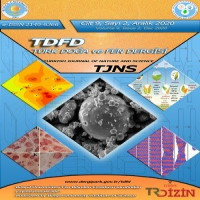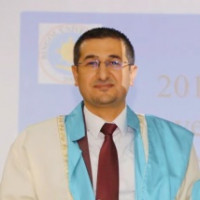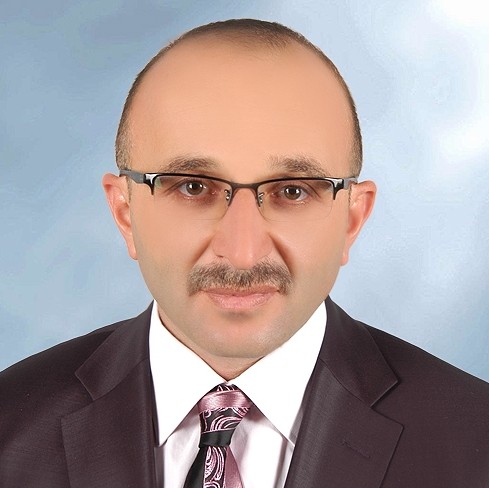Research Article
Aim & Scope
Turkish Journal of Nature and Science is a national and international refereed journal belonging to Bingöl University Science Institute published by Dergipark. Turkish Journal of Nature and Science was established for studies such as original, unpublished research articles, reviews and symposium/congress/conferences papers from Turkey and all over the world to be presented to the science world.
Turkish and English articles are published in the fields of Engineering, Agriculture, Veterinary and Sciences in Turkish Journal of Nature and Science. The journal is only published online and there is no paper print.
Author Guidelines
Scientific studies submitted to our journal;
* Must be original, must not be published
elsewhere and must not be plagiarized. The plagiarism report must be uploaded from DergiPark system.
* Explanations related to the article (supporting organization, project name, etc.) must be written separately.
* After the manuscript is accepted for publication, the "Copyright Transfer Agreement" signed by the corresponding author and all authors should be sent to our journal. Authors are not paid any royalties. With this contract, the full right of publication of the article passes to our journal.
1.
The article must be uploaded by the corresponding author through the “DergiPark” automation system (https://dergipark.org.tr/tdfd) as Microsoft Word file.
The corresponding author is responsible for following all the processes of the
article.
2. The articles sent to our journal for publication should be written in English language. The articles for which the preliminary examination made by the "editor" and / or the "editorial board" is deemed appropriate are published after the opinion of the referees from the related scientific discipline is obtained. After the preliminary control and evaluation processes, the authors' proposed corrections are required to be submitted within 15 days at the latest (it could be extended to 30 days if any experimental studies is requested by referees or editors). Otherwise the article will be rejected.
3. The research articles and reviews must be prepared in accordance with the following rules in order to be published in the journal. If any symposium or declaration presented in the congress is submitted as an article, it must contain additional experimental work and discussion. The articles submitted to the journal will not be evaluated as presented.
a) Research Article: Original and unique studies prepared after a scientific research and experimental study
b)
Review: An original, important, useful and up-to-date article on the editor's
invitation, in which the findings obtained from research conducted by an expert
in that field are evaluated.
4. The cover file must contain English title on , the names, contact information and ORCID numbers of the authors. The article must consist of afilliation, abstract, keywords, Turkish summary, keywords, introduction, materials and methods, results, discussion, conclusion, acknowledgment (if any) and references. Note: The results and discussion sections can be combined under the title of Results and Discussion.
5. The author name (s) must be clearly written, numbered, and addressed below without any academic title. The e-mail address of the corresponding author should also be specified.
6. The abstract should be no more than 200 words. The abstract should include the topic of the research, its purpose, and a summary of the results. The use of non-standard abbreviations and formulas should be avoided wherever possible. Abbreviations should be given in parentheses after long names are written where they were first used, and then only these abbreviations should be used. For example; Short Chain Fatty Acids (SCFAs). The text should continue to be used in the form of SCFA.
7. A maximum of 6 keywords should be used. The words should be written (Enzyme, Molecular weight, Activity, ...) by separating the terms with a comma (,) and leaving a space. The first letters of key words, except for the first keyword and special names, must be written in capital letters.
8. Main headings should be written in bold and capital letters (1. INTRODUCTION) bold in headings 2 (2.1 Second Degree Title) and bold in headings 3 and heading bold in headings 3, all other words with the letter should be written in sentence pattern with all lower case letters (2.1.1 Third degree title).
9. The title of the article in Turkish and English should be short, descriptive and not more than 250 characters.
10. All the remaining parts of the work, except for the titles in Turkish and English, should be written in double-sided.
11. Text should be typed in A4 size paper, 12 point Times New Roman font and double line spacing.
12. A space of 2.5 cm should be left on the right, left, bottom and top of the page.
13. The text should be written in one column, all page numbers should be given.
14. In the article, "Figure" expression for figures and "Table" expression for tables should be used. In addition, the words in Figure 1, Table 1 should be written in bold. The descriptions of the figures should be written in 10 points size on the bottom of the figure. The title of the table should be 10 points size and should be on the table and the content of the table should be at least 8 points. Figure and Table should be given in the relevant places in the main document, not loaded as a separate file or added at the end of the text. The resolution of the figures should be at least 300 dpi. Objects outside of text and tables (images, graphics, shapes) must be in JPEG, PNG or TIFF format. There should be no frame around the shapes. Each shape and table should be included in the text and the number and description belonging to that shape or chart should be found below the shapes and above the tables. Important Note: All decimal numbers in the text or on the tables must be written using points in articles.
15. The formulas should be numbered and the formula number should be shown in parentheses on the right side of the formula. The main characters and variables should be given in italics while numbers and mathematical expressions should be given with normal characters. The formulas should be given as 12 points. The equations should be cited in the text and given as "Equation 1."
16. When writing a unit, the "/" sign should not be used, but must be rendered neutral by leaving a space (EU mg-1 instead of EU / mg).
References
1. References should be typed in Times New Roman characters in 12 point font size.
2. The Vancouver reference system (numbering in square brackets) should be used. The citations made from the conference, dissertation and web pages should start with [1]. References to be given from boks should be given as [1, p.55]. If the citation is given in the text includes the surname of the author; it should be given as Dilsiz et al. [1] or if the article is in English Alberts et al. [1] should be used. Every resource used in the text should be included in the list of references. The reference list should be organized as follows:
Article:
For articles with a number of authors 1-6;
[1] Kwan I, Mapstone J. Visibility aids for pedestrians and cyclists: a systematic review of randomized controlled trials. Accid Anal Prev. 2004; 36 (3): 305-12.
[2] Petitti DB, Crooks VC, Buckwalter JG, Chiu V. Blood pressure levels before dementia. Arch Neurol. 2005; 62 (1): 112-6.
For articles with more than 6 authors;
[3] Hallal AH, Amortegui JD, Jeroukhimov IM, Casillas J, Schulman CI, Manning RJ, et al. Magnetic resonance cholangiopancreatography does not exactly detect common bile duct stones in resolving gallstone pancreatitis. J Am Coll Surg. 2005; 200 (6): 869-75.
Book:
[4] Carlson BM. Human embryology and developmental biology. 4th ed. St. Louis: Mosby; 2009.
[5] Dybvig DD, Dybvig M. Det tenkende mennesket. Filosofiog vitenskapshistorie med vitenskapsteori. 2nd ed. Trondheim: Tapir akademisk forlag; 2003.
Book Section:
[6] Blaxter PS, Farnsworth TP. Social health and class inequalities. In: Carter C, Peel JR, editors. Equalities and inequalities in health. 2nd ed. London: Academic Press; 1976. p. 165-78.
Conference:
[7] Nørvåg K. Space-efficient support for temporal text indexing in a document archive context. 7th European Conference, ECDL.2003. Berlin: Springer; 2003. p. 511-22.
Thesis:
[8] Hasund IK. The discourse markers like in English and likes in Norwegian teenage language: A corpus-based, cross-linguistic study [dissertation]. Bergen: University of Bergen; 2003.
Web:
[9]
Kapperud G. Utbruddsveil [Internet]. I Folkehelseins; 2016 [cited 2016
Jun 30]. Available from: https://www.fhi.no/nettpub/utbruddsveilederen/
Ethical Principles and Publication Policy
Codes of Conduct
The following requirements must be addressed under the title of ethical rules.
1- Ethics committee approval must be obtained for studies conducted in all disciplines including social sciences and for studies on clinical and experimental human and animals requiring ethical committee decision, this approval must be specified and documented in the article.
2- Under this heading, information about the ethical rules should be given under the separate headings for the referee, author and editor.
3- In the articles, there should be a statement that the research and publication ethics are complied with.
4- By referring to national and international standards, ethical principles in the journal and / or website should be specified under a separate heading. For example; In scientific articles sent to journals, the recommendations of the ICMJE (International Committee of Medical Journal Editors) and the International Standards for COPE (Committee on Publication Ethics) Editors and Authors should be taken into consideration.
5- In studies requiring ethical committee permission, information about the permit (name of the board, date and number no) should be included in the method section and also on the first / last page of the article. In case reports, information about the volunteer informed / consent form being signed should be included in the article.
6- The copyright regulations must be followed for the ideas and works of art used.
Turkish Journal of Nature and Science expects authors, readers, researchers, referees and editors to comply with the principles of ethical rules during the publication period of the works. According to the open access guides issued by the Committee on Publication Ethics (COPE), the following standard, general and specific ethical rules and responsibilities should be considered
1. General practices in violation of scientific research and publication ethics:
a) Plagiarism: Presenting others’ ideas, methods, data, applications, writing, figures and works partially or completely as one’s own work without proper source reference.
b) Forgery: Producing data which is not supported by research; regulating or changing presented or published works through the insertion of false data; reporting or publishing such works; or holding incomplete research to be completed.
c) Distortion: Distorting research records and obtained data; pretending to use methods, devices and materials that were not actually used; evaluating data unsuitable to the research itself;, distorting data or results in order to adapt them to established theories or hypotheses; distorting or altering research results to promote or confirm the interests of the sponsoring person or foundation.
d) Repeated publishing: Submitting more than one work of research consisting of the same results in order to obtain associate professorship, examination review, or academic promotion.
e) Slicing: Destroying the integrity of the results of research by slicing it improperly and submitting fragments as specific assessments to gain academic promotion.
e) Unfair authorship: Adding persons who have not actively contributed to the production of the article or failing to add persons who actually did contribute; altering the arrangement of authors’ names improperly and unjustifiably; subtracting the names of actively contributing writers during the publication process or subsequent printings; or adding the name of an author who did not contribute as a way of gaining prestige.
f) Other ethical violations: Failure to indicate clearly the persons, institutions, and foundations that supported the publication of the research; failure to follow ethical rules while experimenting on animals and humans; failure to respect the rights of patients in publications; sharing information of a study for which you were appointed as referee prior to its publication; the misuse of sources, spaces, facilities, and apparatus provided for the research; or accusing someone intentionally and baselessly of ethical violations (Provided by the YÖK Scientific Research and Publication Codes of Conduct, Article Number 8)
2. The Responsibilities of Authors, Referees, and Editors:
Authors’ Responsibilities:
• The author must guarantee the authenticity and originality of the data used in the article.
• The author must make necessary revisions asked by the referee, including the revision of doubtful data and conclusions, errors, and possible instances of plagiarism. If the author fails to make such revisions, he or she must state reasons for doing so.
• Works cited pages must comply with the formatting rules of the journal.
• All work must be free of plagiarism and false data.
• The author shouldnt publish the research in more than one journal.
Referees’ Responsibilities:
Our administrators shall carry out the refereeing process in conformity with all publishing regulations. Cases of plagiarism, repeated publications, errors, and doubtful content will be forwarded to sbe.dergi@bingol.edu.tr, and the referee will be notified. The referee must follow up and report on any data and results related to the inquiry. Our journal anticipates that referees will comply with the following principles:
• Assessments have to be done neutrally.
• There must be no conflicts of interest between referees and authors.
• The referee must indicate deficiencies in terms of work, attribution, rules etc., related to the article.
• Articles should be evaluated blindly and shouldn’t be made public.
Editors’ Responsibilities:
• Editors have the right to accept or decline articles. They have to use this responsibility in a timely way that conforms with publishing schedules.
• Editors should avoid conflicts of interest in accepting or declining articles.
• Editors should only accept articles that are original and contribute to the field of research.
• Editors should refuse articles which are in error, deficient, or violate the rules, requirements, or editorial policy of the journal.
• Editors should enable authors to make corrections to their work after receiving requests for revision (thus enabling publication) or to withdraw their articles before or after any requests for revision are made.
• The editors will ensure that articles will be assessed by at least two referees according to the double-blind peer review system and to keep the identites of those referees confidential.
• Editors will work with “Turnitin” plagiarism software to determine if articles and authentic and original.
Plagiarism Policy
Each review sent to our journal is scanned in a plagiarism program called Turnitin. It is essential that the editors, referees and authors comply with the international punbication ethical rules and article writing rules.
Experimental Research Ethical Rules
In Experimental Research; in the context of Experimental Research Ethical Rules it is mandatory to show the contributions of the supporters, institutions or organizations and their support in research and to respect the ethical rules in human and animal. Within the scope of experimental research, it is the basic principle of our journal that researchers do not harm ecological balance and animal health. The required ethical permits for the studies to be carried out in this context should be taken from the relevant official institutions and attached to the relevant file in the process of sending the article to our journal and the whole responsibility is in the author.
Important Issues That Block Publishing of Articles!
1. If the plagiarism result is high
2. If the editorial board does not approve
3. If the author does not have the ORCID number
4. If the article does not comply with the journal's writing rules
5. If there are no titles and abstracts in Turkish or English and if they are not prepared properly
6. Except for the editorial board's special decision, if the authors exceed two articles per year (one article in each issue)
7. In the preliminary review of the editorial board, if the article is indequate in terms of content, method, discussion, bibliography, language and etc.
8. If the ethics committee document is not added in the studies that need the document, and if the state of the ethics committee document is not indicated in the material and method section
9. Articles that have not completed the evaluation process can not be published until the evaluation / revision process is completed.
Price Policy
No fee required (no article submission charges or processing charges)
Indexes
Citation Indexes
Other Indexes
Journal Boards
Auto-generated board - Please Edit This Title







 Web
Web








Dr. Süleyman İpek was born in 1987 in Diyarbakır, Türkiye. He completed his primary, secondary, and high school education in Diyarbakır, Türkiye. In 2010, he graduated from the Civil Engineering Department at Gaziantep University (Gaziantep, Türkiye) and commenced employment as a research assistant at the Engineering and Architecture Department of Bingöl University (Bingöl, Türkiye).
He holds a Master's degree and a doctorate in Civil Engineering from the Institute of Science and Technology at Gaziantep University, respectively, awarded in 2013 and 2019. He was subsequently appointed as an Assistant Professor in the Architecture Department at Bingöl University. In 2023, he was awarded the Associate Professor degree in Civil Engineering by the Presidency of the Interuniversity Board of Türkiye. In 2024, he was appointed to the role of Associate Professor in the Civil Engineering Department at Bingöl University. In September 2024, he relocated from Bingöl University to the Civil Engineering Department at Yasar University (İzmir, Türkiye), where he continues to be employed.
His research interests lie primarily in the areas of modeling and concrete technology. In particular, he is engaged in investigations into the fresh and hardened properties of concrete, the mechanical and fracture performances of concrete, the production and examination of special types of concrete utilizing waste and commercially available materials, and the modeling of the properties of construction materials and the performance of structural members.
Dr. İpek has published extensively in the field, with over 50 articles in an internationally and nationally indexed journal, as well as three book chapters. He has also participated in 15 international and national congresses, conferences, and symposia, where he presented 15 full-text papers/abstracts. Additionally, he has served as a coordinator and scholar on two TUBITAK-funded projects.
Kind regards,
Assoc. Prof. Dr. Süleyman İPEK
Civil Engineering Department
Yaşar University
İzmir/Türkiye
Phone: +90 (542) 313 4421
e-mail: suleyman.ipek@yasar.edu.tr

Auto-generated board - Please Edit This Title











Danışma Kurulu

Dr. Erhan Sulejmani
Assistant Professor, Faculty of Food Technology and Nutrition, University of Tetova, North Macedonia
Dr. Erhan Sulejmani earned his Doctorate in Technical Sciences in Food Technology from the Faculty of Technology and Metallurgy, Ss. Cyril and Methodius University in Skopje. His doctoral research, supported by an international TUBITAK-funded project, was conducted at the Department of Food Engineering, İnönü University in Malatya, Turkey, and focused on biochemical and chemical changes during the ripening of hard cheeses.
He holds a Master of Agricultural Sciences in Dairy Technology, also from Ss. Cyril and Methodius University, where he investigated the quality of white brined cheese under varying processing conditions. He completed his undergraduate studies in Veterinary Medicine in 2005.
Since 2006, Dr. Sulejmani has been active in academia, teaching and researching in the fields of dairy and meat processing technologies, food chemistry, and food hygiene. He was appointed Assistant Professor (Docent) in 2016 at the University of Tetova. He has participated in numerous national and international projects and is fluent in English.
His research interests include traditional and functional dairy products, cheese biochemistry, food quality and safety, and innovative food processing methods.


Prof. Dr. Selami SELVİ, Çanakkale Onsekizmart Üniversitesi Fen Edebiyat Fakültesi Biyoloji Bölümünden 2002 yılında mezun olmuştur. Balıkesir Üniversitesi Fen Bilimleri Enstitüsü Biyoloji Bölümü Botanik ABD’de 2003-2005 yılları arasında yüksek lisansını, aynı enstitüde 2005-2011 yılları arasında doktorasını tamamlamıştır. Halen Balıkesir Üniversitesi Altınoluk Meslek Yüksekokulu Bitkisel ve Hayvansal Üretim Bölümünde Öğretim üyesi olarak akademik hayatına devam etmektedir. Bitki Morfolojisi ve Anatomisi, Bitki Sistematiği, Bitki Ekolojisi Etnobotanik, Etnofarmakoloji ve Bitki Biyokimyası üzerine çalışmalar yapmaktadır.




This work is licensed under the Creative Commons Attribution-Non-Commercial-Non-Derivable 4.0 International License.





